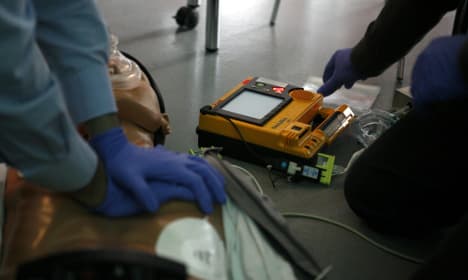Swedish lives saved by first aid text scheme

A trial text-messaging service that alerts people who are trained in resuscitation techniques to nearby cardiac arrest victims has led to a sharp increase in those receiving the life-saving treatment from volunteers, a new Swedish study has shown.
The text-messaging alert system, which uses mobile positioning technology to summon volunteers to the site of a suspected cardiac arrets if within 500 metres, was found to increase the proportion of those receiving cardiopulmonary resuscitation (CPR) by 30 percent.
Published in the New England Journal of Medicine, the study, which was conducted between 2011 and 2012 by Swedish researchers, involved some 10,000 volunteers in Stockholm.
Jacob Hollenberg, a cardiologist at Stockholm hospital Södersjukhuset who helped conduct the study, told The Local that, although similar text alerts had been used in countries such as the US and the Netherlands, the system used in Stockholm is unique.
“We use technology to locate the actual position of the rescuers and correlate these positions to the position of the cardiac arrest victim."
He said that his team had been partly inspired by the experience of one of his fellow-researchers.
“One of my colleagues who is a senior cardiologist was on a bus one day when it stopped and he heard a thud out in front. He didn’t know what had happened and only afterwards learned that someone had had a cardiac arrest just outside the bus.”
As well as hoping the trial will get more people to sign up to CPR the team also wants to do more to get people to use local defibrillators (an electronic device that applies an electric shock to restore the rhythm of a fibrillating heart).
“Not only do we want to alert potential life-savers to perform CPR but also to direct them to the nearest defibrillators. That way we can alert one person to perform CPR and another to get a defibrillator.”
He added that his team has learned of a lot of previous cases where there have been plenty of public defibrillators within a few hundred metres of a patient experiencing cardiac arrest, but the equipment remained unused.
A separate study conducted by Hollenberg and his researchers looked at 30,000 cases of cardiac arrest in Sweden and found that a patient’s chances of survival doubled if they were given CPR.
Comments
See Also
The text-messaging alert system, which uses mobile positioning technology to summon volunteers to the site of a suspected cardiac arrets if within 500 metres, was found to increase the proportion of those receiving cardiopulmonary resuscitation (CPR) by 30 percent.
Published in the New England Journal of Medicine, the study, which was conducted between 2011 and 2012 by Swedish researchers, involved some 10,000 volunteers in Stockholm.
Jacob Hollenberg, a cardiologist at Stockholm hospital Södersjukhuset who helped conduct the study, told The Local that, although similar text alerts had been used in countries such as the US and the Netherlands, the system used in Stockholm is unique.
“We use technology to locate the actual position of the rescuers and correlate these positions to the position of the cardiac arrest victim."
He said that his team had been partly inspired by the experience of one of his fellow-researchers.
“One of my colleagues who is a senior cardiologist was on a bus one day when it stopped and he heard a thud out in front. He didn’t know what had happened and only afterwards learned that someone had had a cardiac arrest just outside the bus.”
As well as hoping the trial will get more people to sign up to CPR the team also wants to do more to get people to use local defibrillators (an electronic device that applies an electric shock to restore the rhythm of a fibrillating heart).
“Not only do we want to alert potential life-savers to perform CPR but also to direct them to the nearest defibrillators. That way we can alert one person to perform CPR and another to get a defibrillator.”
He added that his team has learned of a lot of previous cases where there have been plenty of public defibrillators within a few hundred metres of a patient experiencing cardiac arrest, but the equipment remained unused.
A separate study conducted by Hollenberg and his researchers looked at 30,000 cases of cardiac arrest in Sweden and found that a patient’s chances of survival doubled if they were given CPR.
Join the conversation in our comments section below. Share your own views and experience and if you have a question or suggestion for our journalists then email us at [email protected].
Please keep comments civil, constructive and on topic – and make sure to read our terms of use before getting involved.
Please log in here to leave a comment.